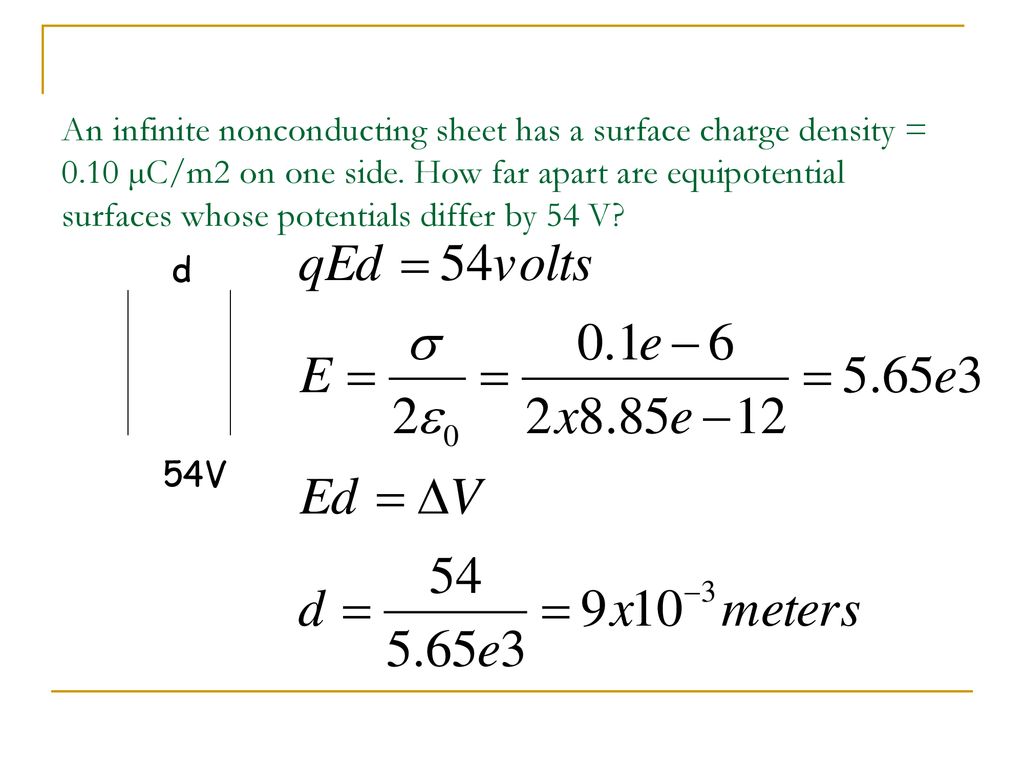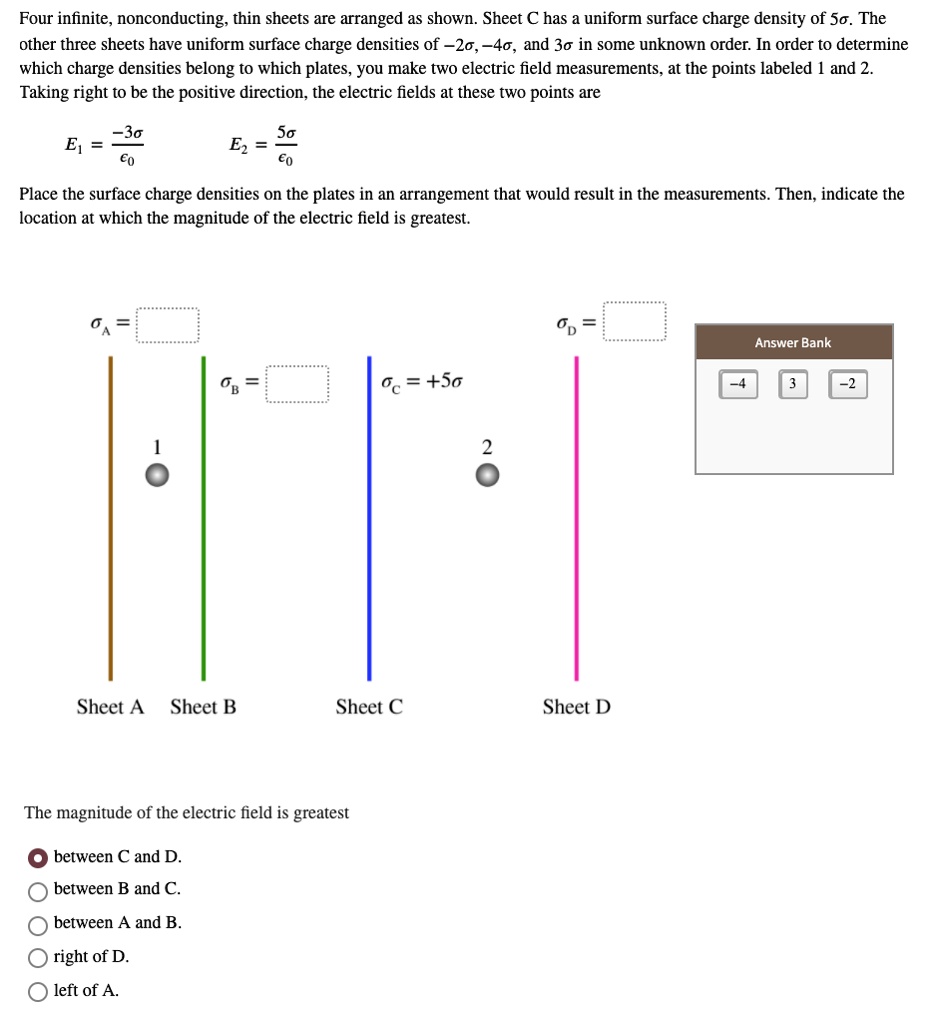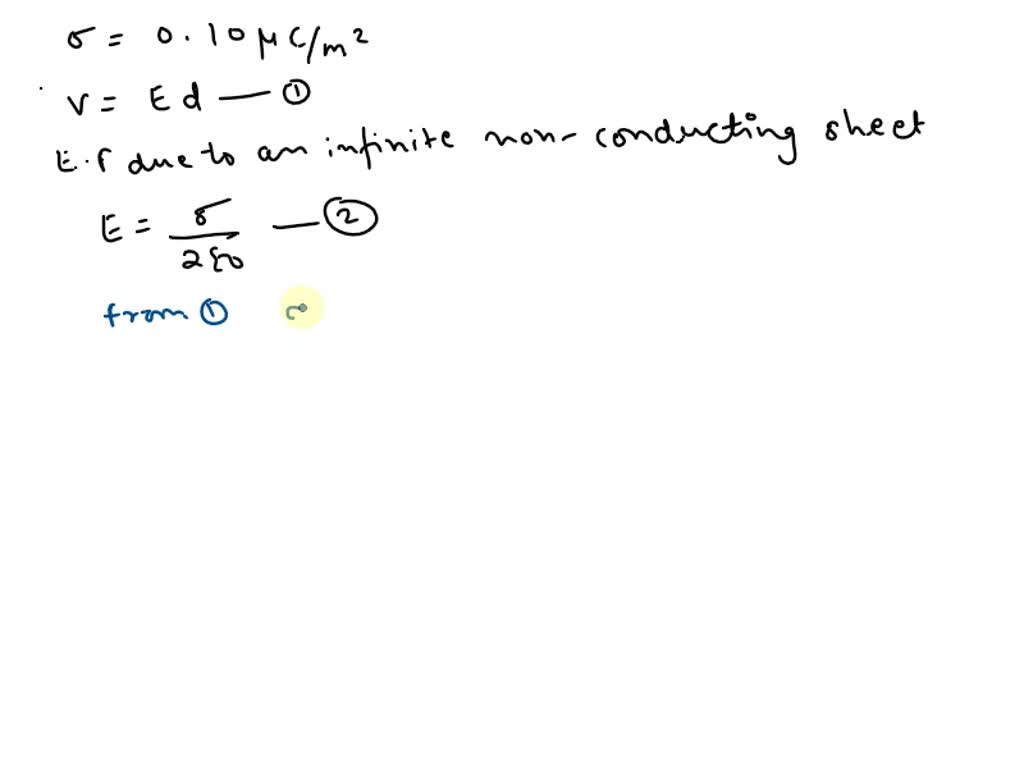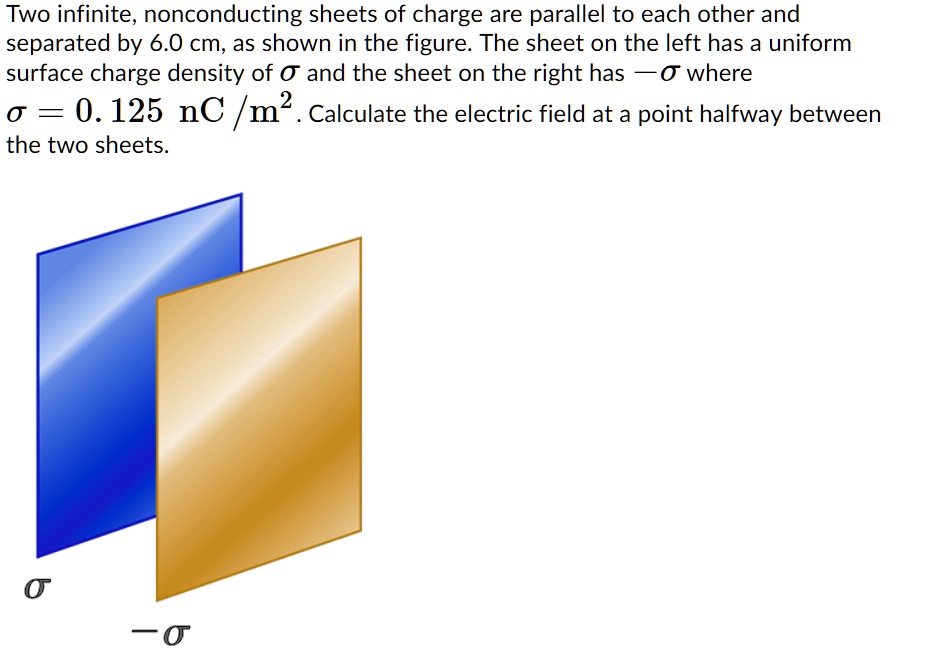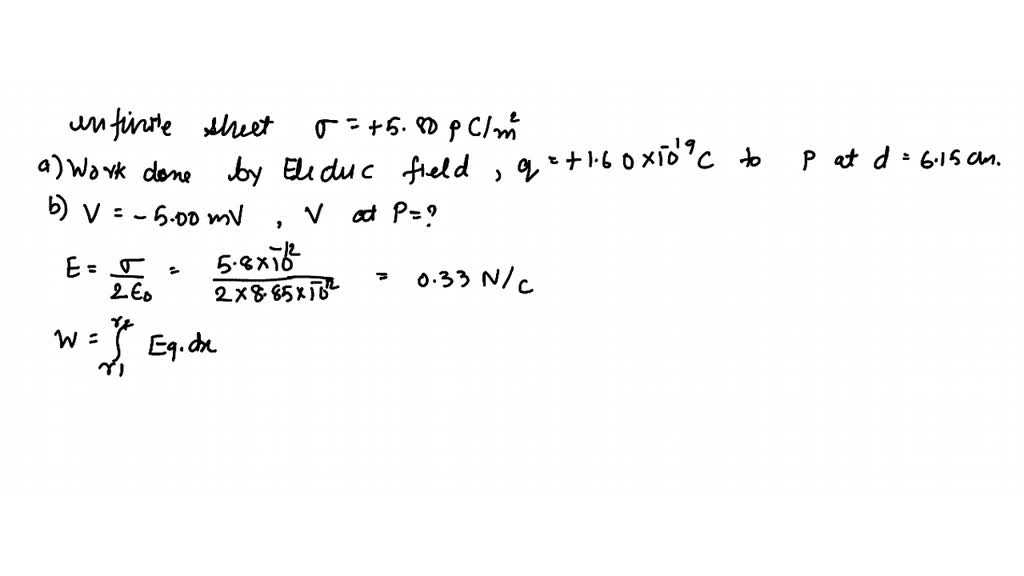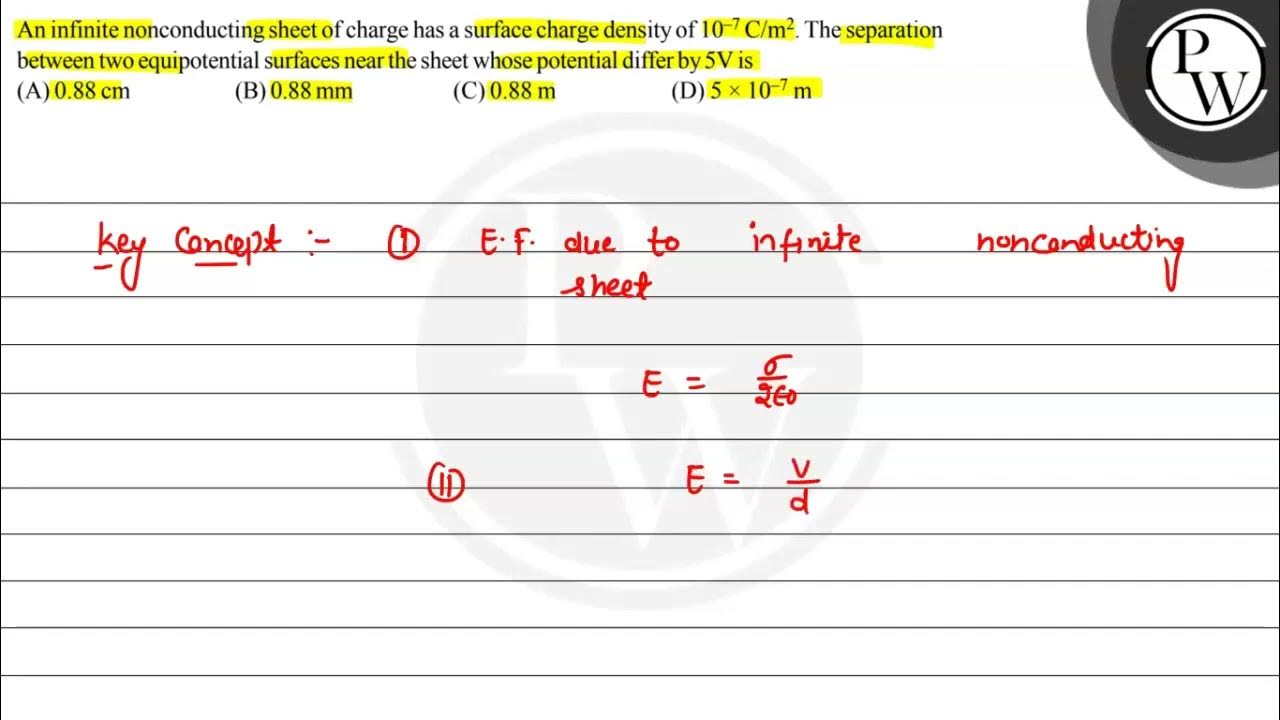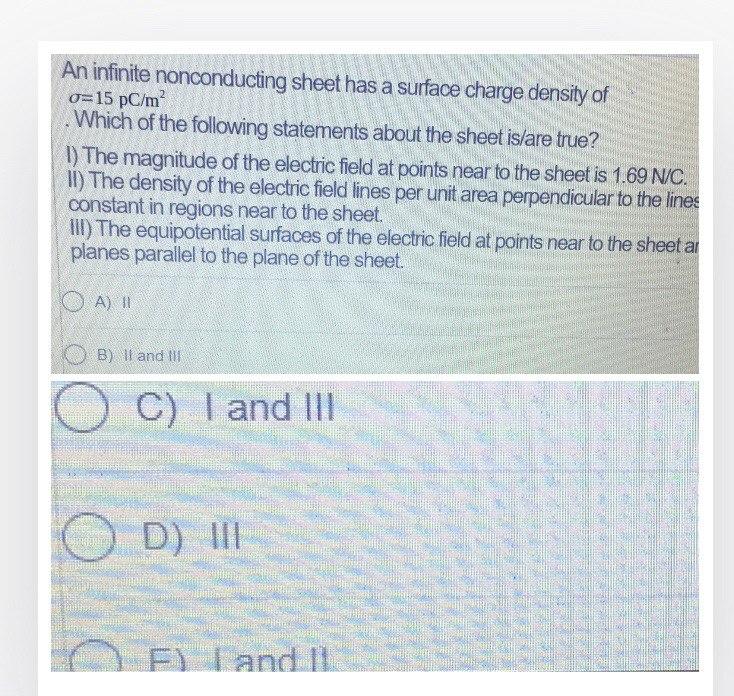An Infinite Nonconducting Sheet Has A Surface Charge Density - 0 cm, inner radius r = 0. In summary, the distance between equipotential surfaces around an infinite charged sheet is directly correlated with the charge. How far apart are equipotential surfaces whose. And the electric field on an infinite sheet is the ratio of its charge density to the relative permittivity. To begin solving, calculate the work done by the electric field to move the charged particle from the sheet to point p using the relation w = f × d,. Any surface over which the. 20 pc / m 2. An infinite nonconducting sheet has a surface charge density σ = 0.10 µc/m2 on one side. With v = 0 at. A plastic disk of radius r = 64.0 cm is charged on one side with a uniform surface charge density = 7.73 fc/m2, and then three quadrants of the.
How far apart are equipotential surfaces whose. An infinite nonconducting sheet has a surface charge density σ = 0.10 µc/m2 on one side. 0 cm, inner radius r = 0. In summary, the distance between equipotential surfaces around an infinite charged sheet is directly correlated with the charge. With v = 0 at. 200 r, and uniform surface charge density σ = 6. 20 pc / m 2. And the electric field on an infinite sheet is the ratio of its charge density to the relative permittivity. Any surface over which the. To begin solving, calculate the work done by the electric field to move the charged particle from the sheet to point p using the relation w = f × d,.
An infinite nonconducting sheet has a surface charge density σ = 0.10 µc/m2 on one side. A plastic disk of radius r = 64.0 cm is charged on one side with a uniform surface charge density = 7.73 fc/m2, and then three quadrants of the. 200 r, and uniform surface charge density σ = 6. 0 cm, inner radius r = 0. And the electric field on an infinite sheet is the ratio of its charge density to the relative permittivity. With v = 0 at. To begin solving, calculate the work done by the electric field to move the charged particle from the sheet to point p using the relation w = f × d,. In summary, the distance between equipotential surfaces around an infinite charged sheet is directly correlated with the charge. How far apart are equipotential surfaces whose. Any surface over which the.
ELECTRIC POTENTIAL February ppt download
How far apart are equipotential surfaces whose. 0 cm, inner radius r = 0. An infinite nonconducting sheet has a surface charge density σ = 0.10 µc/m2 on one side. A plastic disk of radius r = 64.0 cm is charged on one side with a uniform surface charge density = 7.73 fc/m2, and then three quadrants of the. 200.
Solved An infinite nonconducting sheet has a surface charge
A plastic disk of radius r = 64.0 cm is charged on one side with a uniform surface charge density = 7.73 fc/m2, and then three quadrants of the. With v = 0 at. And the electric field on an infinite sheet is the ratio of its charge density to the relative permittivity. Any surface over which the. An infinite.
four infinite nonconducting thin sheets are arranged as shown sheet c
To begin solving, calculate the work done by the electric field to move the charged particle from the sheet to point p using the relation w = f × d,. How far apart are equipotential surfaces whose. With v = 0 at. 0 cm, inner radius r = 0. 20 pc / m 2.
Answered Two infinite, nonconducting sheets of… bartleby
An infinite nonconducting sheet has a surface charge density σ = 0.10 µc/m2 on one side. And the electric field on an infinite sheet is the ratio of its charge density to the relative permittivity. In summary, the distance between equipotential surfaces around an infinite charged sheet is directly correlated with the charge. A plastic disk of radius r =.
SOLVED An infinite nonconducting sheet has a surface charge density σ
How far apart are equipotential surfaces whose. 0 cm, inner radius r = 0. 20 pc / m 2. In summary, the distance between equipotential surfaces around an infinite charged sheet is directly correlated with the charge. An infinite nonconducting sheet has a surface charge density σ = 0.10 µc/m2 on one side.
SOLVED Two infinite, nonconducting sheets of charge are parallel to
And the electric field on an infinite sheet is the ratio of its charge density to the relative permittivity. In summary, the distance between equipotential surfaces around an infinite charged sheet is directly correlated with the charge. A plastic disk of radius r = 64.0 cm is charged on one side with a uniform surface charge density = 7.73 fc/m2,.
SOLVEDAn infinite nonconducting sheet has a surface charge density σ
In summary, the distance between equipotential surfaces around an infinite charged sheet is directly correlated with the charge. And the electric field on an infinite sheet is the ratio of its charge density to the relative permittivity. To begin solving, calculate the work done by the electric field to move the charged particle from the sheet to point p using.
An infinite nonconducting sheet of charge has a surface charge density
And the electric field on an infinite sheet is the ratio of its charge density to the relative permittivity. 0 cm, inner radius r = 0. 200 r, and uniform surface charge density σ = 6. A plastic disk of radius r = 64.0 cm is charged on one side with a uniform surface charge density = 7.73 fc/m2, and.
Solved An infinite, nonconducting sheet has a surface charge
0 cm, inner radius r = 0. A plastic disk of radius r = 64.0 cm is charged on one side with a uniform surface charge density = 7.73 fc/m2, and then three quadrants of the. An infinite nonconducting sheet has a surface charge density σ = 0.10 µc/m2 on one side. How far apart are equipotential surfaces whose. Any.
Solved An infinite nonconducting sheet has a surface charge
20 pc / m 2. Any surface over which the. And the electric field on an infinite sheet is the ratio of its charge density to the relative permittivity. 200 r, and uniform surface charge density σ = 6. In summary, the distance between equipotential surfaces around an infinite charged sheet is directly correlated with the charge.
How Far Apart Are Equipotential Surfaces Whose.
Any surface over which the. An infinite nonconducting sheet has a surface charge density σ = 0.10 µc/m2 on one side. With v = 0 at. 0 cm, inner radius r = 0.
In Summary, The Distance Between Equipotential Surfaces Around An Infinite Charged Sheet Is Directly Correlated With The Charge.
20 pc / m 2. To begin solving, calculate the work done by the electric field to move the charged particle from the sheet to point p using the relation w = f × d,. 200 r, and uniform surface charge density σ = 6. And the electric field on an infinite sheet is the ratio of its charge density to the relative permittivity.
